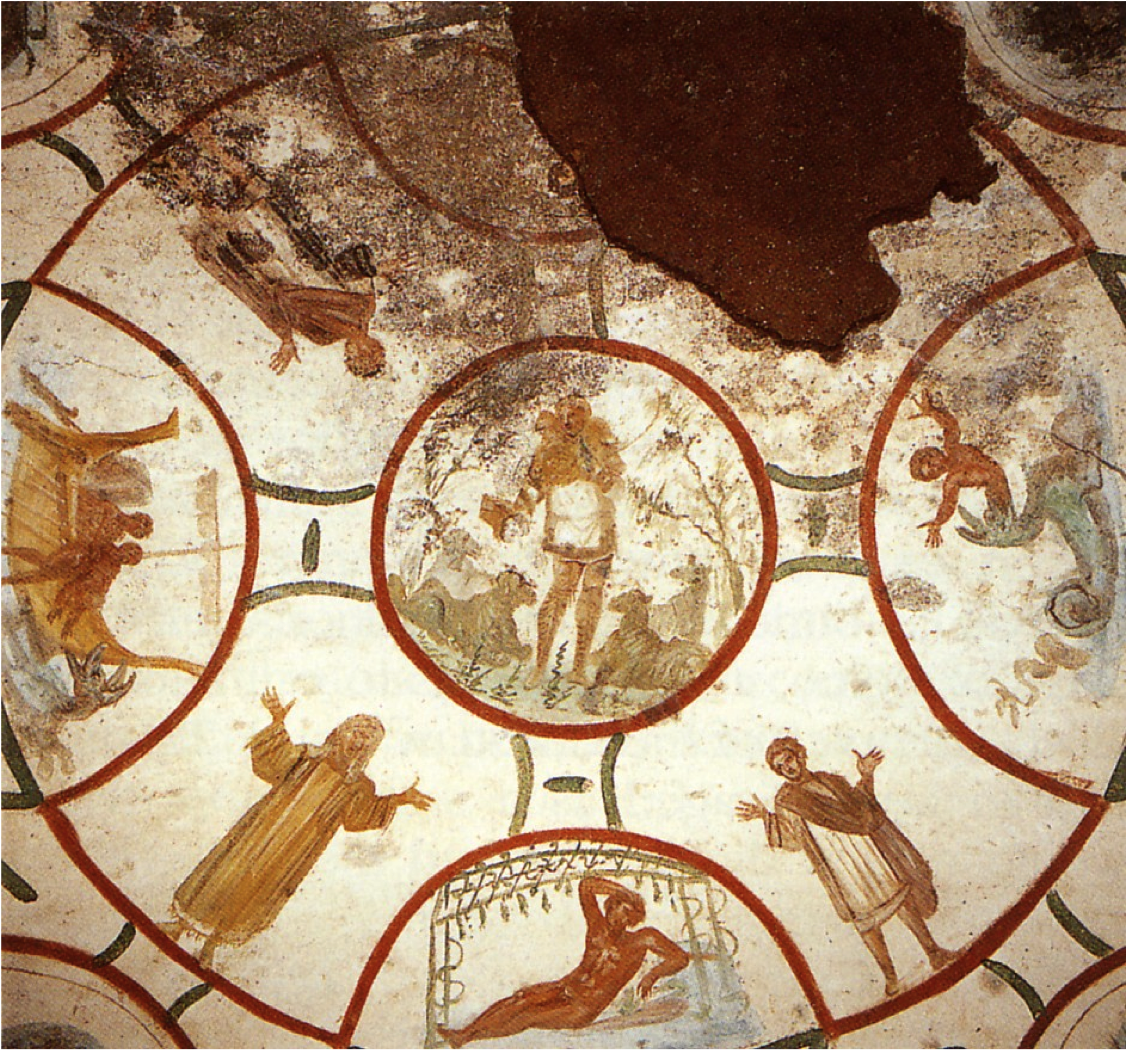Beginning in the second century CE vast burial tunnels known as catacombs were carved into the soft volcanic rock surrounding Rome. The Good Shepherd in the catacombs.

The Good Shepherd Infinite Windows
The Good Shepherd 100-200 AD Artist unknown Catacomb of Priscilla Rome Italy Fresco Dimensions unknown Christian art began as symbolic and humble holding many metaphors.

. 400s AD the Gentile Roman artists in the catacombs painted the heroes of their faith on the rough walls of the underground tombs as everlasting examples of perseverance and courage in times of mortal danger. Thus the motif of the Good Shepherd also represents an Old Testament prophecy that is fulfilled in Jesus. The image of the good shepherd reoccurs in catacomb painting.
Scholars date this statue from about AD. While the model is taken from pagan culture it immediately takes on a Christological significance inspired by the parable of the lost sheep. Images of the Good Shepherd could already be found in the catacombs as this Shepherd Carrying a Lamb from the Catacombs of Domitilla suggests.
The Good Shepherd fresco 250300 BC AD. Jesus as the Good Shepherd. In the catacomb of Callixtus dating from the middle of the third century the Good Shepherd appears again with delicate modelling of form face and drapery.
The site is located in an ancient Roman quarry and is the burial site for many early Christian martyrs. Callixtus Good Shepherd Catacombs. Catacomb of Marcellinus and Peter.
Roman law outlawed burials within the city limits. A painting of Jesus actual face on the roof of this catacomb is used instead of depicting him as the Good Shepherd the reason relating to the date of this painting as it is from the late fourth century a time when the Roman Empire had the freedom to practice Christianity as a legalized religion. Shepherds were common enough as garden figures in pagan villas.
It derives from Jesus parable of the good shepherd John 1011-18 and from a dozen or so other passages in the gospels where he presents himself as a shepherd. The image of the Good Shepherd who lays down his life for his sheep is found in the Gospel of. One of the images represented the most in the art of the catacombs is the Good Shepherd.
The walls of the catacombs are decorated with murals depicting early Christian. It relates to one of the most important themes in. I love the icon its really lovely.
Stunning icon of Jesus Christ. Painting from the Catacomb of Priscilla Rome. The use of a shepherd with a sheep on his shoulders to symbolize Christ was already traditional when this image was created.
The Good Shepherd around 200 Fresco Catacombs of Priscilla Rome. The Catacombs of Priscilla on the Via Salaria in Rome are situated in a quarry that during Roman time was used for burials. Painting of the Good Shepherd at the Catacomb of Domitilla The Pact of the Catacombs is an agreement signed by 42 1 bishops of the Catholic Church at a meeting following Mass in the Catacombs of Domitilla near Rome on the evening of 16 November 1965 three weeks before the close of the Second Vatican Council.
The Catacombs of Priscilla were used for early Christian burials in the second through fourth centuries CE. This image of Christ as the Good Shepherd was painted in the Catacombs of Saint Callixtus in the 3rd century. The Good Shepherd.
Christians had been killed since Neros First Imperial Persecution began in c. This typical Roman bucolic subject of Hermes the ram-carrier was adapted by early Christian artists to portray Christ the Good Shepherd. What was once considered a pose of Classical sculpture was now a symbol of Jesus as the Good Shepherd to the Christians who created this piece.
The catacombs of San Callisto were built sometime after 150 CE. 64 AD when Nero burned down Rome the Magnum incendium. An example of the Good Shepherd being used as a syncretic image is in the mural of a Roman catacomb which shows the Good Shepherd in the centre see Fig.
Good shepherd motif third century CE. Rome Catacombs of Priscilla The Good Shepherd. Early Christian art found in the catacombs in Rome shows Jesus carrying a lamb on his shoulders.
The Good Shepherd fresco at the catacombs of Saints Pietro and Marcellino in Rome for instance depicts Jesus Christ as the Good Shepherd. Artists would try to take symbols that may have been pagan or that represented something non-Christian to make it have a more significant meaning. The birds in the trees and the approaching animals are taken.
One of the earliest known paintings of our Lord. Christ the Good Shepherd Catacomb icon. Good shepherd wall painting Priscilla catacombs The Good Shepherd Catacombs of Rome 284 AD The Good Shepherd Catacomb of Domitilla 200 CE The Good Shepherd catacombs of St.
As a shepherd Jesus Christ leads the sheep into the right path just as Christians believe the Son. They represented a romantic ideal of the bucolic way of life and the more solid merit of good husbandry and economy but they could. Posted by Yvonne on Sep 11th 2021.
Jesus as the Good Shepherd mid-3rd century.

A Chorus Of Voices The Reception History Of The Parables The Good Shepherd In Early Christian Art P 2 The Roman Catacombs

The Good Shepherd By Early Christian Painter Italian
![]()
Good Shepherd Catacomb Painting

The Good Shepherd Infinite Windows

Three Of The Oldest Images Of Jesus Portray Him As The Good Shepherd

0 comments
Post a Comment